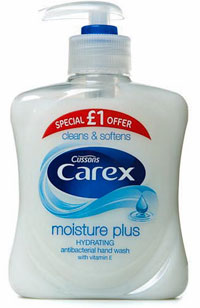 Ingredients
Ingredients-
- Aqua
- Sodium laureth sulfate
- Glycerin
- Lauramidopropyl betaine
- Cocamidopropyl PG-dimonium chloride phosphate
- Laureth-4
- Polyquaternium-39
- Lactic acid
- Hexylene glycol
- Parfum
- Sine adipe lac
- Styrene acrylate copolymer
- PEG-40 hydrogenated castor oil
- Trideceth-9
- Pentylene glycol
- Tetrasodium EDTA
- Sodium chloride
- Sodium benzoate
- Hexyl cinnamal
- Limonene
- Phenoxyethanol
- Methylparaben
- Ethylparaben
- Butylparaben
- Propylparaben
- Isobutylparaben
Published August 2011
Protecting antibacterial hand wash.
Ingredients
Surfactants
Surfactants are there to remove dirt which they do by solubilising the grease that makes it cling to the skin. Surfactant molecules have water-attracting heads and oil-attracting tails. The latter penetrate the grease and the former drag it into the water. In Carex the surfactants are made from coconut oil and are gentle and lather well. They are sodium laureth sulfate which has a negative water-seeking end, lauramidopropyl betaine which has a neutral water-seeking end, and cocamidopropyl PG-dimonium chloride phosphate which has a positive water-seeking end. This last surfactant leaves behind a protective layer on the skin. Laureth-4 also acts as a neutral surfactant but it has a dual role as an emulsifier.
Moisturisers
The skin's protective layer of natural oil is removed by washing to be replaced by polyquaternium-39, which is a positively charged polymer, and it does this by virtue of the fact that it adheres to the skin. It is made from the chemicals acrylic acid, acrylamide, and diallyldimethylammonium chloride. Glycerin (aka glycerol, propane-1,2,3-triol) keeps the skin moist. Most glycerin is a by-product of biodiesel manufactured from plant oils. It is also used in cough linctus and liqueurs to make them syrupy.
Emulsifiers
These are needed to prevent the oil and water-based ingredients from separating into two layers. Those in Carex are pentalene glycol and hexylene glycol. They consist of five and six carbon chains respectively with an hydroxy (OH) group at each end. Longer chain emulsifiers are styrene acrylate copolymer, which is also used in photocopiers and laser beam printers, PEG-40 hydrogenated castor oil, and trideceth-9. The last of these also spreads the Carex more evenly over the skin.
Antibacterials
Hands are a major agent for transmitting disease pathogens so antibacterial agents sodium benzoate and phenoxyethanol are added. To prevent germs breeding in the Carex ingredients themselves, various other antimicrobial agents are added to them, namely methylparaben, ethylparaben, butylparaben, propylparaben, and isobutylparaben. All are variants of parabenzoic acid (chemical formula HOC6H4CO2H), in which the acidic H has been replaced by a neutral organic group to increase solubility in oil-based ingredients.
Other ingredients
Lactic acid (aka milk acid, 2-hydroxypropanoic acid, C3H6O3) controls the pH and is also used in medical drips, beer brewing and limescale removers.
Sine adipe lac (i.e. 'without fat milk') is just a fancy way of saying skimmed milk although what type of milk is not specified.
Tetrasodium EDTA (aka ethylene tetra-acetic acid, Na4C10H12N2O8) counteracts hard water by keeping calcium ions soluble. It is used in detergents for the same reason.
Hexyl cinnamal (chemical formula C15H20O) smells of camomile.
Limonene is a hydrocarbon (chemical formula C10H16) present in the peel of oranges from which it is extracted commercially.